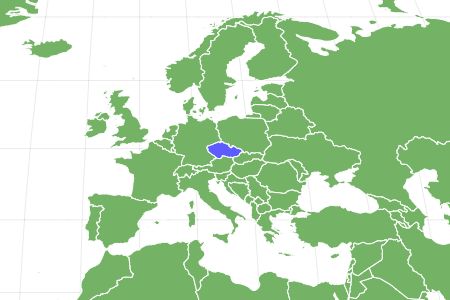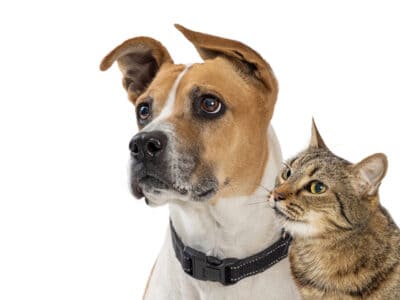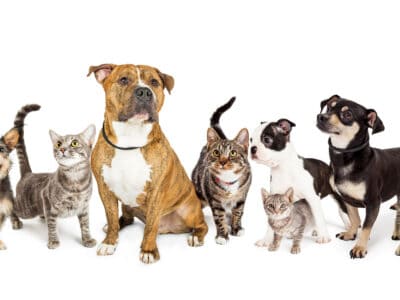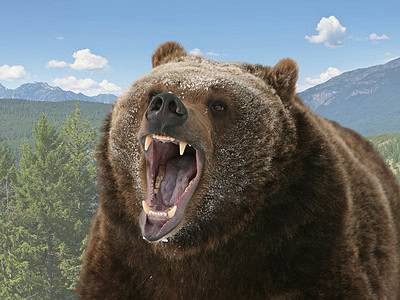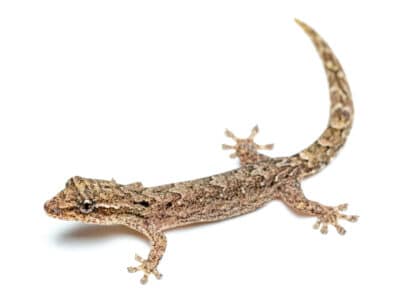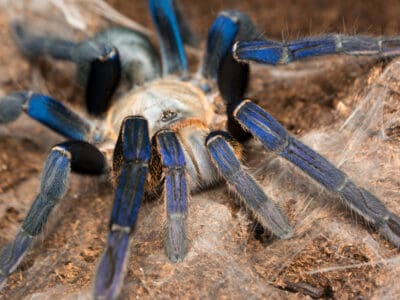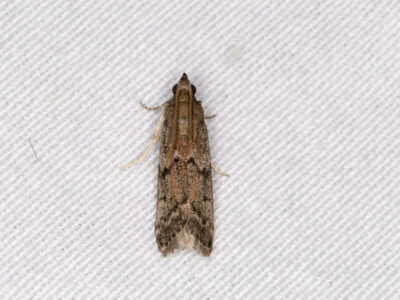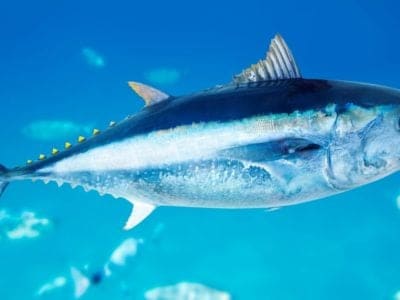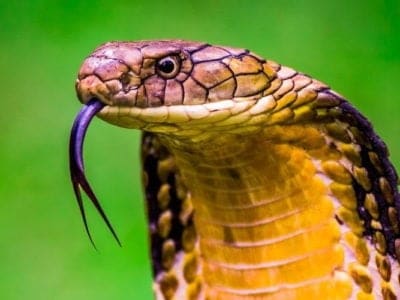Cesky Fousek
Canis lupus
An affectionate hunting dog!
Advertisement
Cesky Fousek Scientific Classification
- Kingdom
- Animalia
- Phylum
- Chordata
- Class
- Mammalia
- Order
- Carnivora
- Family
- Canidae
- Genus
- Canis
- Scientific Name
- Canis lupus
Read our Complete Guide to Classification of Animals.
Cesky Fousek Conservation Status
Cesky Fousek Facts
Cesky Fousek as a Pet:
- General Health
- Energy Level
- Shedability
- Trainability
- Intelligence
- Tendency to Chew
- Size
- Family and kid friendliness
- Yappiness / Barking
- Moderate
- Separation Anxiety
- High
- Preferred Temperature
- Average climate
- Exercise Needs
- High
- Friendly With Other Dogs
- Moderate
- Pure bred cost to own
- $1200
- Dog group
- Sporting
- Male weight
- 62-75 lbs
- Female weight
- 49-62 lbs
This post may contain affiliate links to our partners like Chewy, Amazon, and others. Purchasing through these helps us further the A-Z Animals mission to educate about the world's species.
View all of the Cesky Fousek images!
The Cesky Fousek (pronounced Chess-key Foe-sek) is a Czech dog breed with wiry hair, a long “moustache,” and a short bushy tail.
Combined with a unique pattern of white, brown, and orange colorations, it almost has an old, wise appearance. Likely originating in the Middle Ages from the kingdom of Bohemia (what is now the Czech Republic), the Cesky Fousek was bred as an expert gundog to find and retrieve hunting game. The more precise term “pointing dog” comes from the way it points its muzzle in the appropriate direction of the game.
See all of our expert product reviews.
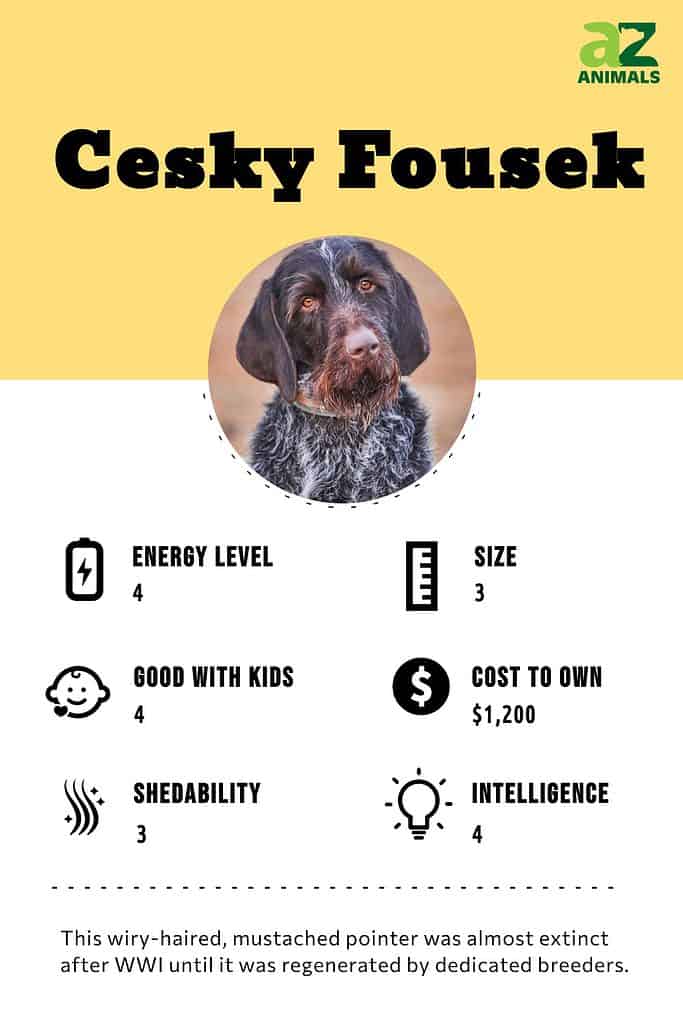
This breed also goes by the name Bohemian wirehaired pointing Griffon and rough-coated Bohemian pointer. One important caveat is that this breed may be very hard to find in certain parts of the country. This breed is not well-known outside of the Czech Republic, even though it actually arrived in the United States in the late 19th century. Depending on where you live, you may need to travel far to find specialized breeders.
Evolution
The Cesky Fousek dates back to the 13th century and is believed to be the oldest wirehair in existence. It was the most popular pointing dog in the Czech and Slovakian Republics up until the first World War. After the chaos and destruction of that war – the dog was almost extinct. Thanks to dedicated breeders – the Cesky Fousek was regenerated and is now one of the most revered gun dogs in Europe.
3 Pros and Cons of Owning a Cesky Fousek
| Pros! | Cons! |
|---|---|
| Highly active This breed will easily satisfy owners who love to exercise with their dogs. | Needs constant attention This breed requires plenty of exercise and attention throughout the entire day. |
| Loyal and obedient The Cesky Fousek adapts easily to intense training. Sports, tricks, hunting, and other tasks all come naturally to it. | Destructive behavior If left alone, the Cesky Fousek can easily become bored and anxious, leading it to engage in destructive behavior. It can become lost and purposeless without some kind of guidance from its owner. It is not a good idea to leave it alone for long stretches of time. |
| Easy-going and affectionate The Cesky Fousek has little of the stubbornness that afflicts some breeds of dogs. It is laid back and friendly, always ready to engage with its owner. It gets along reasonably well with children and other animals. | Prone to some health problems This includes cancer, ear infections, and hip conditions. |
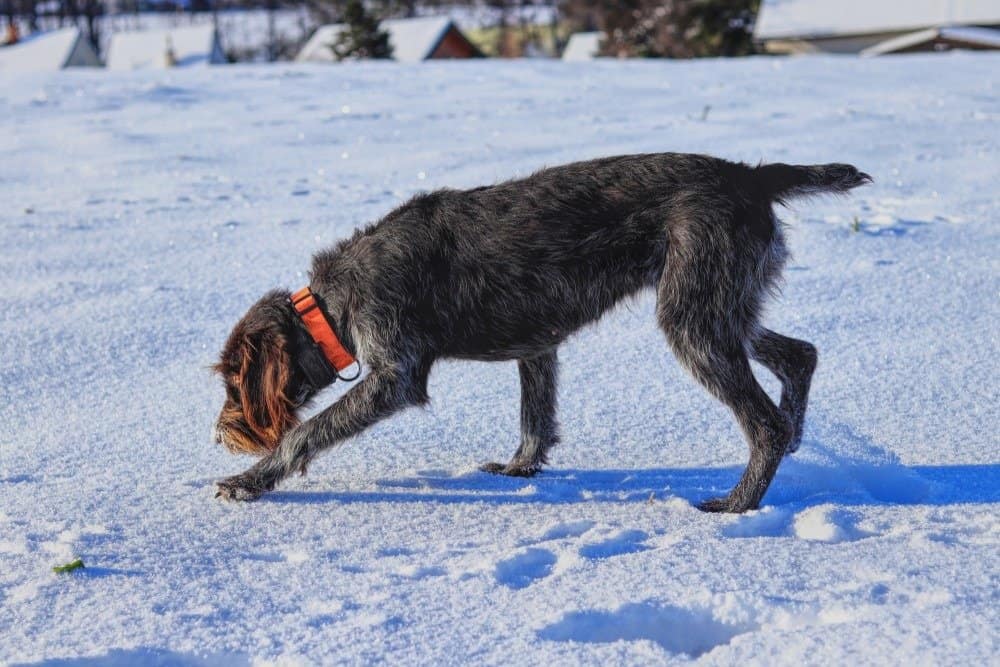
The Cesky Fousek dates back to the 13th century and is believed to be the oldest wirehair in existence.
©Vaclav Sonnek/Shutterstock.com
Size and Weight
The Cesky Fousek is a muscular medium- to large-sized dog breed. Males weigh quite a bit more than females.
Health and Entertainment for your Cesky Fousek
See all of our expert product reviews.
| Height (Male) | 24 to 26 inches |
|---|---|
| Height (Female) | 23 to 24 inches |
| Weight (Male) | 62 to 75 pounds |
| Weight (Female) | 49 to 62 pounds |
Common Health Issues
The Cesky Fousek is prone to many common health issues that afflict other dog breeds, including cancer, ear infections, and hair loss. This breed also has a tendency to inherit hip dysplasia, a genetic disorder that arises from the abnormal development of the hip socket. In its worst form, this condition can cause lameness and arthritis that follow the dog throughout its entire life. Because this condition arises early in the dog’s development, you should make sure the breeders, store, or adoption agency has screened for potential health issues as a puppy.
It is also a good idea to have regular physical examinations and ear examinations. If you can afford it, then you might want to think about getting semi-regular tests to catch issues early on. To sum up this breed’s most common health problems:
- Cancer
- Hip Dysplasia
- Ear Infections
- Alopecia (bald spots)
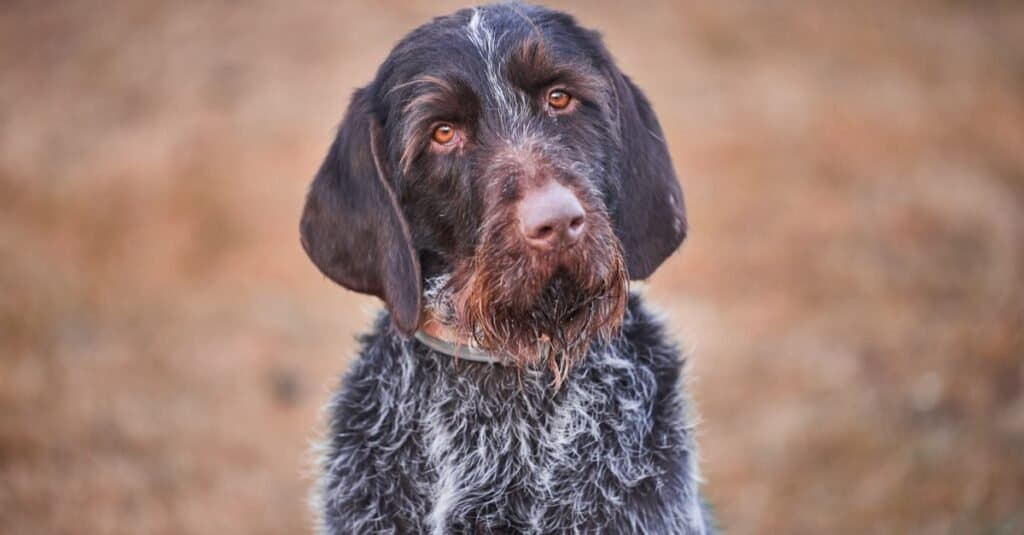
The Cesky Fousek is believed to be an ancient dog, first setting its roots centuries ago in the time of the Kingdom of Bohemia.
©Jan Danek jdm.foto/Shutterstock.com
Temperament and Behavior
The Cesky Fousek has a warm and friendly personality that’s eager to please. Its behavior combines intelligence with obedience, toughness, and tenacity with a gentle and playful side. Through training, exercise, and playtime, there are endless ways to interact positively with this breed. This dog’s personality and behavior, honed over centuries of selective breeding, are also ideal for hunting trips.
No matter the conditions, it is in its element when tracking down game. These trips also serve as a good way to strengthen the bond between dog and owner. For all these reasons, the Cesky Fousek is a good rural dog. But as long as you have enough open space to exercise in, even urban dwellers may come to love this affable dog. Just make sure that it has plenty to occupy its wandering and energetic mind.
How to Take Care of a Cesky Fousek
The Cesky Fousek requires a good deal of care and attention to maximize the happiness of the dog and the amount of enjoyment you derive from owning this breed. Regular health checkups and screenings from the time it’s a puppy are good ideas. Over time, you may come to develop a very deep bond with the breed. You should treat it as a companion and partner as much as a pet.
The Best Dog Food for Cesky Fousek Dogs
The Cesky Fousek requires about 4 cups of high-quality dog food a day to support its very active lifestyle. You can also hand out treats regularly to encourage good behavior and assist with training. This breed burns through energy very quickly, but you should nevertheless watch out for signs of weight gain. Opt for a high-protein food that fuels their active lifestyle and builds lean muscle while nourishing their whole body, from nose to tail.
A-Z Animals chooses Purina ONE SmartBlend True Instinct Natural High Protein Adult Dry Dog Food as the best dog food for Cesky Fousek Dogs.
This kibble is a one-stop go-to for your Cesky Fousek’s 100% complete and balanced diet. Made primarily with real beef, it’s 32% protein for the energy this breed needs on all their adventures. It’s a great source of glucosamine, a nutrient that is proven to improve joint mobility and longevity. It’s rich in antioxidants including Omega-6 fatty acids for a tough immune system that you can see on the outside in a healthy coat.
Find Purina ONE SmartBlend True Instinct Natural High Protein Dog Food on Chewy or Amazon.
- High protein beef and salmon recipe for strong muscles and heart health
- Supports muscles, joints, and active lifestyle
- Omega 6 fatty acids for shiny coat and healthy skin
Maintenance and Grooming
The Cesky Fousek is a moderate shedder that requires regular brushing about once or twice every week. A normal comb or pin brush should be sufficient to remove loose hair and dirt. Unless the dog is particularly dirty, it is not necessary to give it regular baths, just regular cleaning with a cloth. Other important grooming advice includes weekly teeth brushes, semi-regular nail trimmings, and constant ear cleaning to lower the risk of infection. If the dog gets wet on one of its many adventures outside, then you should dry it as thoroughly as possible to prevent it from catching a chill.
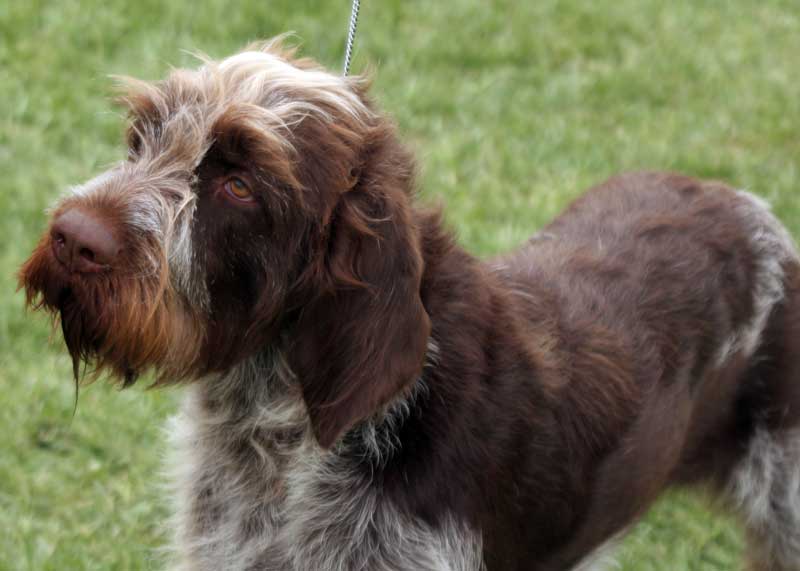
Training is so important to the Cesky Fousek that it serves as an important means of strengthening the bond with its owner.
©Srinayan Puppala / Creative Commons – Original
Training
The Cesky Fousek responds to training with the obedient air of a loyal companion. With a bit of guidance, this breed can be taught to perform any tricks or tasks that the owner desires. The Cesky Fousek fortunately has little of the stubborn streak that characterizes many other dog breeds, so you should not struggle to teach it what you want. Although primarily bred to assist its owner with hunting, the Cesky Fousek is also agile and fast enough to participate in some athletic or sports competitions. Training is so important to this breed that it serves as an important means of strengthening the bond with its owner.
Exercise
The Cesky Fousek is a high-energy breed that may require as much as an hour of exercise a day. Otherwise, it may engage in destructive behavior to work off its excess energy. So before buying, you should make sure that you have access to plenty of open space for the dog to run and play. If you don’t have a yard or nearby open space, then you should be prepared to take it on frequent trips to the park. It should ideally get about 20 miles of exercise every week. Because it was bred as a hunting dog, the Cesky Fousek takes very well to fetch and ball games. It’s also an excellent swimmer that can easily traverse pools or bodies of water without a problem.
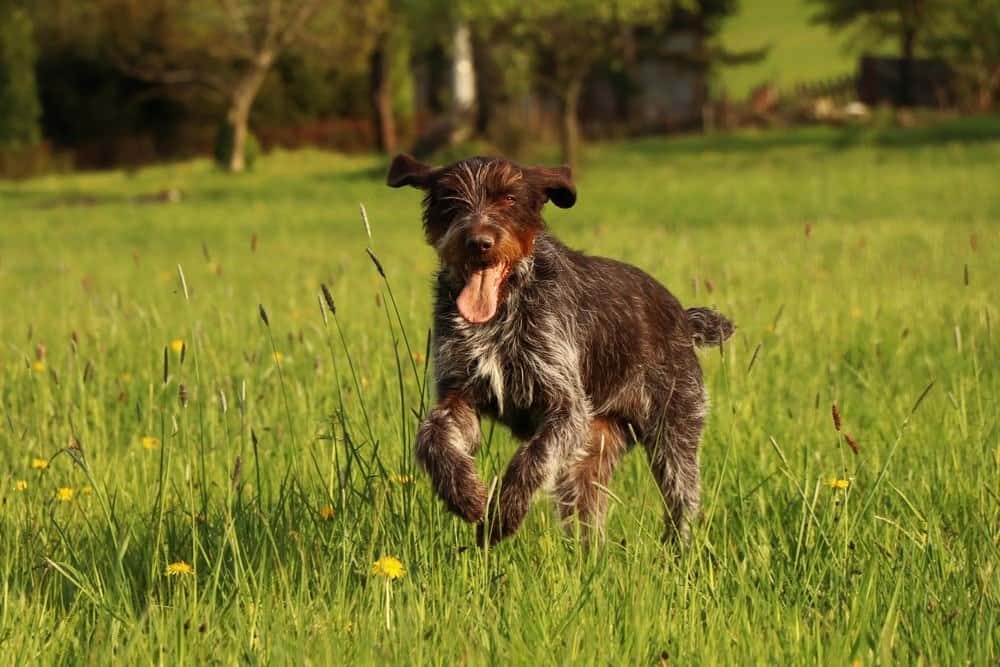
The Cesky Fousek is a high-energy breed that may require as much as an hour of exercise a day.
©Vaclav Sonnek/Shutterstock.com
Puppies
The Cesky Fouseks are very responsive puppies that can be trained and socialized easily from an early age. As long as you attend to its needs and make the extra effort to screen for adverse health conditions, the puppy should be set for a long and successful life.
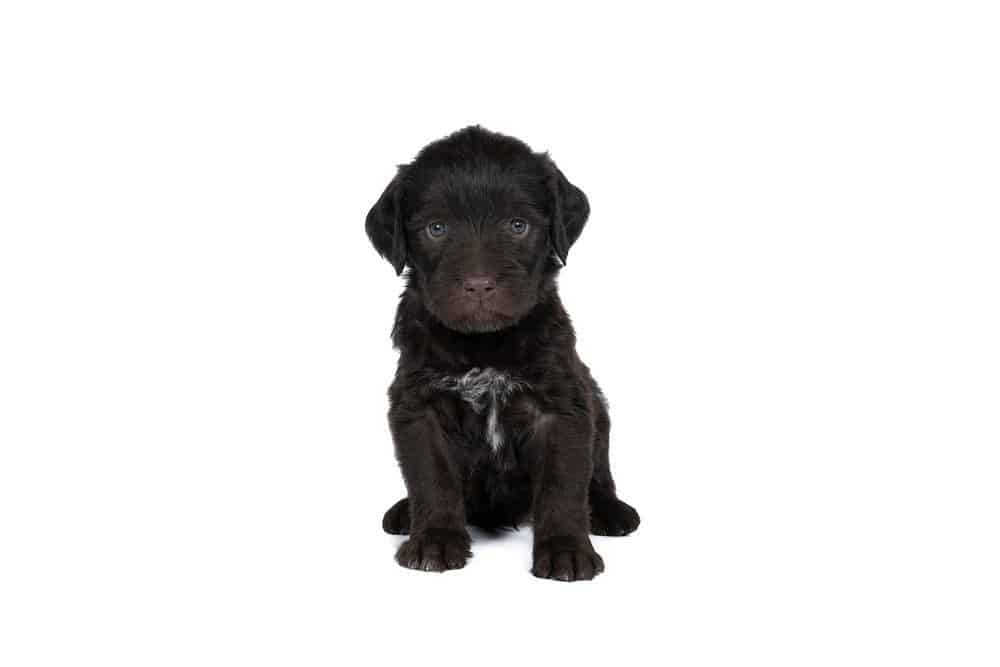
Cesky Fousek puppies are eager and easy to train.
©Leoniek van der Vliet/Shutterstock.com
Cesky Fouseks and Children
Due to its level-headed and friendly nature, the Cesky Fousek works very well as a family pet. It is simultaneously well-behaved and very protective of its owner. However, you should be aware that the breed’s energetic behavior may be a problem around younger children. It is therefore a good idea to have a responsible caretaker or supervisor around at all times to provide the dog company and companionship.
Breeds Similar to the Cesky Fousek
The Cesky Fousek is very similar to the German wirehaired pointer and the French wirehaired pointing Griffon. However, these are relatively rare and specialized breeds. If you are looking for more mainstream hunting dogs similar to the Cesky Fousek, then you should check out these breeds instead:
- Irish Setter – Adorned in a fiery red and orange coat of fur, the Irish setter is a fellow gundog with a gregarious and good-natured personality. This incredibly athletic breed has a lean, wiry appearance with big droopy ears and long elegant fur. It has a staunch reputation as a good work dog and an affectionate companion.
- Labrador Retriever – This friendly and spirited retriever is one of the most popular dog breeds in the United States. It requires lots of exercise and training to really satisfy this breed. It is therefore not for owners who want a low-maintenance dog. But for those who have the time and inclination to take care of it, the Labrador retriever is a loving and playful dog.
- Golden Retriever – This incredibly popular dog breed has many of the same attributes and characteristics as the Labrador retriever. It is loyal, playful, friendly, athletic, and obedient. It is also a medium to a high-maintenance dog that requires plenty of attention and exercise. But the golden retriever will delight children and adults alike.
Popular Names for the Cesky Fousek
The website madpaws.com lists these dog names as the most popular:
- Charlie
- Bella
- Buddy
- Max
- Molly
- Ruby
- Oscar
- Coco
Cesky Fousek FAQs (Frequently Asked Questions)
Where do Cesky Fousek originate?
The Cesky Fousek originated from what is now the modern Czech Republic. The name itself translates roughly to mean Czech fousy (meaning whiskers or rough hair). The scientific name for the domesticated dog as a whole is Canis lupis familiaris. This scientific name roughly translates to familiar dog.
Are Cesky Fouseks good family dogs?
The Cesky Fousek is a very good family dog: not just because of its friendly and easy-going nature, but because it requires constant attention and exercise. This breed is appropriate for an entire family to really care for. If you live alone, then you may want to think about how you will take care of this dog full time before purchasing one. You may need to seek out some assistance when you are not with the dog because it should not be left alone for long periods of time.
How big do Cesky Fousek dogs get?
Males can reach a maximum of 75 pounds. Females are usually much smaller at around 49 to 62 pounds. Both sexes can measure anywhere between 23 to 26 inches high.
How old do Cesky Fousek dogs get?
The typical lifespan for the Cesky Fousek is between 12 and 15 years. If the dog is in particularly good health, then it can potentially live longer.
Are Cesky Fouseks good hunting dogs?
The Cesky Fousek is a very capable hunting dog. Athletic, intelligent, obedient, and dedicated to its task, this breed excels most when it is out on the hunt, pointing out the location of the potential game. Non-hunters can still enjoy this breed, but you should be prepared to deal with its instinctive hunting behavior.
Are Cesky Fouseks herbivores, carnivores, or omnivores?
Cesky Fouseks are Omnivores, meaning they eat both plants and other animals.
What Kingdom do Cesky Fouseks belong to?
Cesky Fouseks belong to the Kingdom Animalia.
What class do Cesky Fouseks belong to?
Cesky Fouseks belong to the class Mammalia.
What phylum to Cesky Fouseks belong to?
Cesky Fouseks belong to the phylum Chordata.
What family do Cesky Fouseks belong to?
Cesky Fouseks belong to the family Canidae.
What order do Cesky Fouseks belong to?
Cesky Fouseks belong to the order Carnivora.
What genus do Cesky Fouseks belong to?
Cesky Fouseks belong to the genus Canis.
What type of covering do Cesky Fouseks have?
Cesky Fouseks are covered in Hair.
What is an interesting fact about Cesky Fouseks?
Cesky Fouseks are affectionate hunting dogs!
What is the scientific name for the Cesky Fousek?
The scientific name for the Cesky Fousek is Canis lupus.
Thank you for reading! Have some feedback for us? Contact the AZ Animals editorial team.
Sources
- David Burnie, Dorling Kindersley (2011) Animal, The Definitive Visual Guide To The World's Wildlife / Accessed December 1, 2008
- Tom Jackson, Lorenz Books (2007) The World Encyclopedia Of Animals / Accessed December 1, 2008
- David Burnie, Kingfisher (2011) The Kingfisher Animal Encyclopedia / Accessed December 1, 2008
- David Burnie, Dorling Kindersley (2008) Illustrated Encyclopedia Of Animals / Accessed December 1, 2008
- Dorling Kindersley (2006) Dorling Kindersley Encyclopedia Of Animals / Accessed December 1, 2008
- Wag! / Accessed October 30, 2020
- Gundog / Accessed October 30, 2020

